Related Research Articles

Predation is a biological interaction where one organism, the predator, kills and eats another organism, its prey. It is one of a family of common feeding behaviours that includes parasitism and micropredation and parasitoidism. It is distinct from scavenging on dead prey, though many predators also scavenge; it overlaps with herbivory, as seed predators and destructive frugivores are predators.

The meerkat or suricate is a small mongoose found in southern Africa. It is characterised by a broad head, large eyes, a pointed snout, long legs, a thin tapering tail, and a brindled coat pattern. The head-and-body length is around 24–35 cm (9.4–13.8 in), and the weight is typically between 0.62 and 0.97 kg. The coat is light grey to yellowish-brown with alternate, poorly-defined light and dark bands on the back. Meerkats have foreclaws adapted for digging and have the ability to thermoregulate to survive in their harsh, dry habitat. Three subspecies are recognised.

In zoology, a crepuscular animal is one that is active primarily during the twilight period, being matutinal, vespertine/vespertinal, or both. This is distinguished from diurnal and nocturnal behavior, where an animal is active during the hours of daylight and of darkness, respectively. Some crepuscular animals may also be active by moonlight or during an overcast day. Matutinal animals are active only before sunrise, and vespertine only after sunset.

Foraging is searching for wild food resources. It affects an animal's fitness because it plays an important role in an animal's ability to survive and reproduce. Foraging theory is a branch of behavioral ecology that studies the foraging behavior of animals in response to the environment where the animal lives.
Neophobia is the fear of anything new, but is directly correlated with conditions such as OCD or autism spectrum disorder. In its milder form, it can manifest as the unwillingness to try new things or break from routine. In the context of children, the term is generally used to indicate a tendency to reject unknown or novel foods. Food neophobia, as it may be referred to, is an important concern in pediatric psychology.

The scaly-breasted munia or spotted munia, known in the pet trade as nutmeg mannikin or spice finch, is a sparrow-sized estrildid finch native to tropical Asia. A species of the genus Lonchura, it was formally described and named by Carl Linnaeus in 1758. Its name is based on the distinct scale-like feather markings on the breast and belly. The adult is brown above and has a dark conical bill. The species has 11 subspecies across its range, which differ slightly in size and color.

Hoarding or caching in animal behavior is the storage of food in locations hidden from the sight of both conspecifics and members of other species. Most commonly, the function of hoarding or caching is to store food in times of surplus for times when food is less plentiful. However, there is evidence that some amount of caching or hoarding is done in order to ripen the food, called ripening caching. The term hoarding is most typically used for rodents, whereas caching is more commonly used in reference to birds, but the behaviors in both animal groups are quite similar.

Aposematism is the advertising by an animal to potential predators that it is not worth attacking or eating. This unprofitability may consist of any defenses which make the prey difficult to kill and eat, such as toxicity, venom, foul taste or smell, sharp spines, or aggressive nature. These advertising signals may take the form of conspicuous coloration, sounds, odours, or other perceivable characteristics. Aposematic signals are beneficial for both predator and prey, since both avoid potential harm.
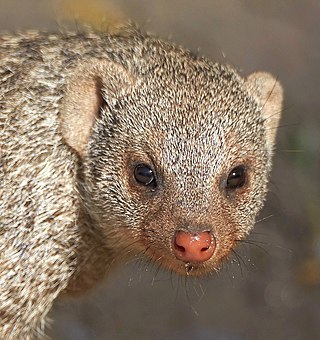
The banded mongoose is a mongoose species native from the Sahel to Southern Africa. It lives in savannas, open forests and grasslands and feeds primarily on beetles and millipedes. Mongooses use various types of dens for shelter including termite mounds. While most mongoose species live solitary lives, the banded mongoose live in colonies with a complex social structure.

Optimal foraging theory (OFT) is a behavioral ecology model that helps predict how an animal behaves when searching for food. Although obtaining food provides the animal with energy, searching for and capturing the food require both energy and time. To maximize fitness, an animal adopts a foraging strategy that provides the most benefit (energy) for the lowest cost, maximizing the net energy gained. OFT helps predict the best strategy that an animal can use to achieve this goal.

The difficulty of defining or measuring intelligence in non-human animals makes the subject difficult to study scientifically in birds. In general, birds have relatively large brains compared to their head size. The visual and auditory senses are well developed in most species, though the tactile and olfactory senses are well realized only in a few groups. Birds communicate using visual signals as well as through the use of calls and song. The testing of intelligence in birds is therefore usually based on studying responses to sensory stimuli.

Cannibalism is the act of consuming another individual of the same species as food. Cannibalism is a common ecological interaction in the animal kingdom and has been recorded in more than 1,500 species. Human cannibalism is well documented, both in ancient and in recent times.
Cooperative breeding is a social system characterized by alloparental care: offspring receive care not only from their parents, but also from additional group members, often called helpers. Cooperative breeding encompasses a wide variety of group structures, from a breeding pair with helpers that are offspring from a previous season, to groups with multiple breeding males and females (polygynandry) and helpers that are the adult offspring of some but not all of the breeders in the group, to groups in which helpers sometimes achieve co-breeding status by producing their own offspring as part of the group's brood. Cooperative breeding occurs across taxonomic groups including birds, mammals, fish, and insects.
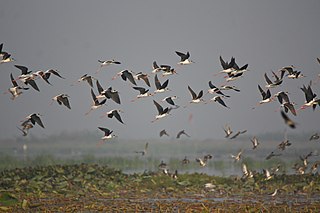
A flock is a gathering of individual birds to forage or travel collectively. Avian flocks are typically associated with migration. Flocking also offers foraging benefits and protection from predators, although flocking can have costs for individual members.

Tool use by non-humans is a phenomenon in which a non-human animal uses any kind of tool in order to achieve a goal such as acquiring food and water, grooming, combat, defence, communication, recreation or construction. Originally thought to be a skill possessed only by humans, some tool use requires a sophisticated level of cognition. There is considerable discussion about the definition of what constitutes a tool and therefore which behaviours can be considered true examples of tool use. A wide range of animals, including mammals, birds, fish, cephalopods, and insects, are considered to use tools.
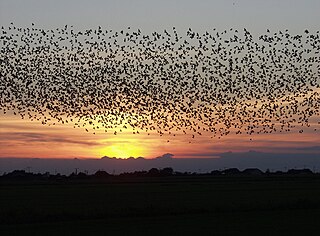
Collective animal behaviour is a form of social behavior involving the coordinated behavior of large groups of similar animals as well as emergent properties of these groups. This can include the costs and benefits of group membership, the transfer of information, decision-making process, locomotion and synchronization of the group. Studying the principles of collective animal behavior has relevance to human engineering problems through the philosophy of biomimetics. For instance, determining the rules by which an individual animal navigates relative to its neighbors in a group can lead to advances in the deployment and control of groups of swimming or flying micro-robots such as UAVs.
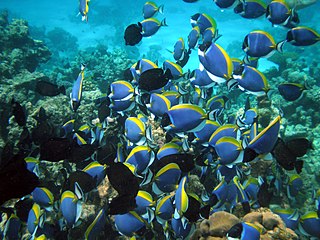
In biology, any group of fish that stay together for social reasons are shoaling, and if the group is swimming in the same direction in a coordinated manner, they are schooling. In common usage, the terms are sometimes used rather loosely. About one quarter of fish species shoal all their lives, and about one half shoal for part of their lives.
Native to both South and Central America, Cane toads were introduced to Australia in the 1930s and have since become an invasive species and a threat to the continent's native predators and scavengers.
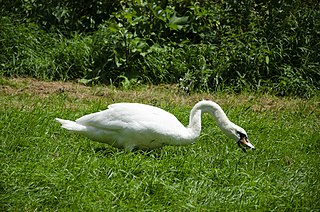
Avian foraging refers to the range of activities and behaviours exhibited by birds in their quest for food. In addition to their unique body adaptations, birds have a range of described behaviours that differ from the foraging behaviours of other animal groups. According to the foraging habitat, birds may be grouped into foraging guilds. Foraging includes a range of activities, starting with the search for food, making use of sensory abilities, and which may involve one or more birds either of a single or even of multiple species. This is followed by locomotion and movements to obtain or capture the food, followed by the processing or handling of the foods prior to ingestion. Like all organisms foraging entails balancing the energy spent and energy gained. The high metabolic rate of birds, among the highest in the homoeotherm groups, constrains them to ensure a net positive gain in energy and have led evolutionary ethologists to develop the idea of optimal foraging.
A variety of behaviours whereby people are highly selective in what they eat and do not eat are known as picky eating or selective eating. Picky eating is common in younger children and can be a cause of concern for parents. It is also seen in many adults. There is no generally accepted definition of picky eating. It is generally associated with increased food neophobia. It can be associated with rejecting mixed or lumpy foods. It can also be associated with sensory sensitivity.
References
- 1 2 3 Marples, Nicola M.; Roper, Timothy J.; Harper, David G. C. (1998). "Responses of Wild Birds to Novel Prey: Evidence of Dietary Conservatism". Oikos. 83 (1): 161. doi:10.2307/3546557. JSTOR 3546557.
- 1 2 3 Marples, N. M.; Kelly, D. J. (1999). "Neophobia and Dietary Conservatism:Two Distinct Processes?". Evolutionary Ecology. 13 (7–8): 641–653. doi:10.1023/A:1011077731153. ISSN 0269-7653. S2CID 27737756.
- ↑ Barnett, Ca; Bateson, M.; Rowe, C. (2007). "State-dependent decision making: educated predators strategically trade off the costs and benefits of consuming aposematic prey". Behavioral Ecology. 18 (4): 645–651. doi: 10.1093/beheco/arm027 . ISSN 1465-7279.
- ↑ Sibley, R. M.; Brigham, A. J. (1999). A Review of the Phenomenon of Neophobia. In DP Cowan and CJ Feare (Eds.), Advances in Vertebrate Pest Management. Furth: Filander Verlag. pp. 67–84. ISBN 978-3930831166.
- 1 2 3 Marples, N. M.; Brakefield, P. M. (1995). "Genetic variation for the rate of recruitment of novel insect prey into the diet of a bird". Biological Journal of the Linnean Society. 55 (1): 17–27. doi:10.1016/0024-4066(95)90026-8.
- ↑ Kelly, D. J. (2001). Dietary conservatism in passerines: the influences of novel odour and novel colour (unpublished doctoral dissertation). Dublin, Republic of Ireland: Trinity College Dublin
- ↑ Kelly, David J.; Marples, Nicola M. (2004). "The effects of novel odour and colour cues on food acceptance by the zebra finch, Taeniopygia guttata". Animal Behaviour. 68 (5): 1049–1054. doi:10.1016/j.anbehav.2004.07.001. S2CID 53205231.
- ↑ Thomas, Robert J.; Bartlett, Laura A.; Marples, Nicola M.; Kelly, David J.; Cuthill, Innes C. (2004). "Prey selection by wild birds can allow novel and conspicuous colour morphs to spread in prey populations". Oikos. 106 (2): 285–294. doi:10.1111/j.0030-1299.2004.13089.x.
- ↑ Thomas, R. J.; Marples, N. M.; Cuthill, I. C.; Takahashi, M.; Gibson, E. A. (2003). "Dietary conservatism may facilitate the initial evolution of aposematism". Oikos. 101 (3): 458–466. doi:10.1034/j.1600-0706.2003.12061.x. ISSN 0030-1299.
- 1 2 3 4 Marples, N. M.; Quinlan, M.; Thomas, R. J.; Kelly, D. J. (2007-07-09). "Deactivation of dietary wariness through experience of novel food". Behavioral Ecology. 18 (5): 803–810. doi: 10.1093/beheco/arm053 . ISSN 1045-2249.
- ↑ Marples, Nicola M.; Mappes, Johanna (2011). "Can the dietary conservatism of predators compensate for positive frequency dependent selection against rare, conspicuous prey?". Evolutionary Ecology. 25 (4): 737–749. doi:10.1007/s10682-010-9434-x. ISSN 0269-7653. S2CID 22086923.
- 1 2 McMahon, Keith; Conboy, Allison; O'Byrne-White, Elise; Thomas, Robert J.; Marples, Nicola M. (2014). "Dietary wariness influences the response of foraging birds to competitors". Animal Behaviour. 89: 63–69. doi:10.1016/j.anbehav.2013.12.025. S2CID 54433290.
- ↑ Thomas, Robert J.; King, Tracey A.; Forshaw, Hannah E.; Marples, Nicola M.; Speed, Michael P.; Cable, Joanne (2010). "The response of fish to novel prey: evidence that dietary conservatism is not restricted to birds". Behavioral Ecology. 21 (4): 669–675. doi: 10.1093/beheco/arq037 . ISSN 1465-7279.
- ↑ Richards, E. Loys; Alexander, Lucille G.; Snellgrove, Donna; Thomas, Robert J.; Marples, Nicola M.; Cable, Joanne (2014). "Variation in the expression of dietary conservatism within and between fish species". Animal Behaviour. 88: 49–56. doi:10.1016/j.anbehav.2013.11.009. S2CID 53174146.
- ↑ Harris, Holly A.; Fildes, Alison; Mallan, Kimberley M.; Llewellyn, Clare H. (2016). "Maternal feeding practices and fussy eating in toddlerhood: a discordant twin analysis". International Journal of Behavioral Nutrition and Physical Activity. 13 (1): 81. doi: 10.1186/s12966-016-0408-4 . ISSN 1479-5868. PMC 4944306 . PMID 27412445.
- ↑ Smith, Andrea D.; Herle, Moritz; Fildes, Alison; Cooke, Lucy; Steinsbekk, Silje; Llewellyn, Clare H. (2017). "Food fussiness and food neophobia share a common etiology in early childhood". Journal of Child Psychology and Psychiatry. 58 (2): 189–196. doi:10.1111/jcpp.12647. PMC 5298015 . PMID 27739065.
- ↑ Pietrewicza, A. T., & Kamil, A. G. (1981). Search images and the detection of cryptic prey: an operant approach. In A. G. Kamil, & T. D. Sargent (Eds.), Foraging Behavior: Ethological and Psychological Approaches (pp. 311-332). New York: Garland STPM Press.
- ↑ Tinbergen, Niko (1960). "The natural control of insects in pine woods: vol. I. Factors influencing the intensity of predation by songbirds". Archives Néerlandaises de Zoologie. 13 (3): 265–343. doi:10.1163/036551660X00053 – via eurekamag.com.